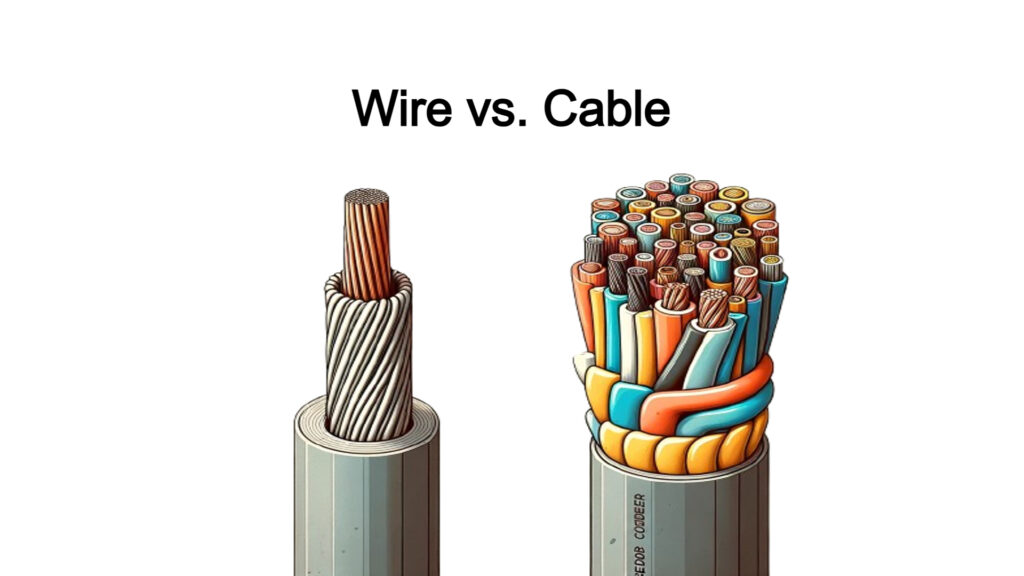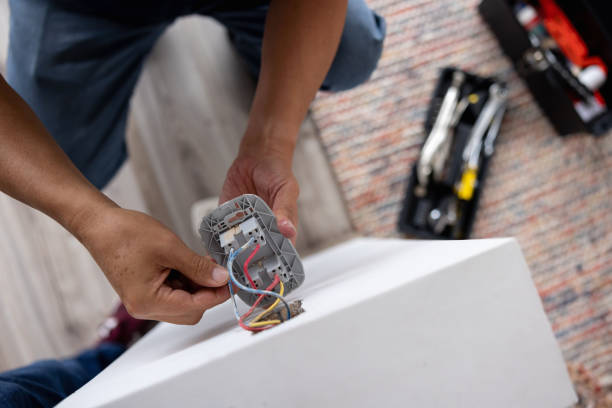Choosing the right electrical wire when setting up a safe and easy home is important. Residential Buildings are mainly wired with those types of electrical wires, so to aid you in understanding clearly about which wires to use in what part of your home, this guide is going to walk you through various types of electrical wires used in building of the residential buildings.
But first, we’ll talk about what is the difference between a copper and an aluminium wire and how the wire colour is more important than just looking good. If you’re sprucing up your home or curious about the items that keep your lights on, this introductory walk through the contents of your walls will help illuminate what’s going on.
Basic Terminology: Wire vs. Cable

Have you ever wondered how your gadgets stay ready and lights on at home? The far end of the wires and cabling behind the scenes kick it all off. So let’s dive into the basics to understand what probably have their walls running within your home.
What is a Wire? A wire is a conductor in which a single current flows from one point to another, such as copper or aluminium wire. It’s always wrapped in some insulation so it doesn’t touch the other wires, or anything else that should not conduct electricity. Imagine a one way road of electricity that directs it exactly where we need it.
What is a Cable? Unlike a cable, however, a highway is like a big one. It brings a bunch of wires together that are all insulated from each other, in order to do more complicated things with electricity. Let’s take cable supplying home air conditioning as an example, it usually contains several wires bundled into one protective sheath that carries different types of current for maintaining cool.
Whether you need repairs or upgrades at home, you need to know the difference between wire and cable. Each role has its own purpose, and doing it wrong can generate bad systems or worse, safety hazards. They even have a range of colours that depict their function, red for the live wires, carrying power from its source; green or bare ones, the safety net, that is, grounding any stray electricity.
Next time you see a wire or cable remember there’s more than just metal or plastic; there’s an important piece of our homes that keeps us powered safely and efficiently. Whether setting up new holiday lights or checking an old appliance, always consider what kind of electrical conductor you are dealing with to ensure everything works smoothly and safely.
If you’re setting up or renovating a home, picking the right type of electrical wire is as much about safety, efficiency and compatibility with local codes as it is anything else. Inside residential buildings, there are common types of wires that break down in this section so the homeowner can make informed decisions.
Related: How to Find Generator Repair in San Antonio TX
Common Types of Electrical Wire Used in Homes

- Romex® Cable (Non-Metallic Sheathed Cable) Romex® is a brand name that has become synonymous with non-metallic sheathed cable (NM cable). It’s widely used in dry, indoor settings for running through the walls, ceilings, and floor joists. The typical NM cable includes at least one hot wire, a neutral wire, and a grounding wire, all encased in a durable plastic sheath. It’s popular due to its ease of installation and safety features, making it a top choice for wiring lights, outlets, and appliances in most of the house.
- THHN/THWN Wire THHN and THWN are two types of insulation used on individual wires that are often found in the conduits of residential buildings. THHN stands for Thermoplastic High Heat-resistant Nylon-coated, while THWN is Thermoplastic Heat and Water-resistant Nylon-coated. These wires are ideal for both indoor and outdoor usage because of their resistance to heat, moisture, and oil. Electricians typically use these wires in basements, garages, and other areas where the wires are enclosed in conduits.
- UF Cable (Underground Feeder Cable) UF cable is similar to Romex®, but it’s designed to be used in wet locations and can be buried directly underground without additional protection. It has a sturdy plastic sheeting that withstands moisture and other environmental conditions. This type of cable is perfect for powering outdoor lighting, garden tools, and other exterior installations.
- BX Cable (Armored Cable) Also known as armoured cable, BX cable contains wires encased in a flexible metal sheath, which provides extra protection and makes it suitable for areas where the cable might be exposed to physical damage. This type of wiring is used in residential buildings where the wires need protection from external factors but still require flexibility for installation around obstacles.
- Coaxial Cable While not used for transmitting power, coaxial cable is crucial in homes for internet connections and cable television. It features a central wire surrounded by an insulator, a metallic shield, and an outer layer of insulation. Its design helps prevent signal interference, making it ideal for high-quality data transmission.
- Aluminum Wire Used predominantly in the mid-20th century before being superseded by copper for new installations due to safety concerns, aluminium wiring is still present in some older homes. It requires special handling and connectors to ensure safety, as it expands and contracts more than copper and can lead to loose connections over time.
Colour Coding of Electrical Wires
However, you may not think of it as understanding what the colour of electrical wires symbolises, but it’s only used to make your home’s wiring system look organised but it is also important for safety, simplifying repairs, upgrading and many more. So even beginners will be able to demystify the rainbow of colours they see in residential wiring.
Why Color Coding Matters The colours on electrical wires are like a road map: they’ll tell you what each wire does, and how to treat it. It prevents connections which might cause electrical malfunctions or safety hazards during installations and maintenance. Recognizing wire colours is important for anyone working on electrical systems be that for professional or DIY purposes.
In the United States, The National Electrical Code (NEC) has set it as a standard of using the electrical wire colours. Here’s what each colour typically indicates:
- Black: On the other hand, this colour indicates hot wire which carries power from your service panel (breaker box) into all the devices and outlets in your home. Be careful, it can zap you if you’re not careful and live.
- Red: Red wires are another hot wire used to link pieces of your home electrical system which you may find running to switches, hardwired smoke detectors, or dividing circuits into several branches.
- Blue and Yellow: Hot wires are also painted in these colours. Usually feeders for three way and four way switches, these are blue wires, and yellow wires commonly used as switch legs for ceiling fans, structural lights, and outlets controlled by switches.
- White: Usually reserved for the neutral wire, this colour is typically some shade of grey. After it passes the various devices pulling the power, it completes the circuit by bringing the current back to the electrical panel.
- Green and Bare Copper: In one of these colours, grounding wires are used. In helping direct any stray electrical current from people and back to the ground external to your home, they help.
Whereas the above guidelines cover the basics, there are special cases and exceptions, mostly in older homes or homes that have been modified over the years. In switch loops and, for instance, white wires are marked with black or red tape to designate that they are hot wires. Before working with wires, double check and test always.
Any time you are working on an electric circuit you should always turn off the power at the breaker box. Before touching any wires confirm that they do not live with the use of a voltage tester. If you’re ever unsure what a wire does, or if the colour coding doesn’t make too much sense, it’s a good idea to consult with or hire a licensed electrician. So, from there remember that correctly identifying and handling wires can stop accidents; they also can mean that your home’s electrical system operates correctly and safely.
For homeowners, a little wire colour knowledge may help do simple things like change a light fixture or just figure out why a switch isn’t working. It is a part of training for safe and efficient electrical work for aspiring electricians. For kids who you’re explaining electricity to, colour coding can be a great way to get the conversations started on how electricity works and how to keep it safe.
Lastly, the electrical wires colour coding like stated above is a basic thing on any residential electrical system that helps with conducting maintenance, troubleshooting, and safe handling. By being familiar with these colours and their meanings, you will be able to better understand the intricacies of your home’s electrical system, as well as being able to perform basic electrical tasks with greater confidence.
Related: Top 10 Colors of Electrical Wires: The Basics
Choosing the Right Wire Gauge
As with any wiring in the home, making the right wire gauge choice is as important as choosing a suitable wire type. The thickness of a wire is called the “gauge”. It sounds simple, but it makes a huge difference to the safety and efficiency of the electrical system in your home. Let’s see how to decide what wire gauge works best for what tasks, and why.
Wire Gauge Numbers are the gauge number representing the thickness of a wire. While you may think you should go with a smaller gauge number, the larger a gauge number, the thinner the wire. Thicker wires have higher ability to carry more current and therefore are used in higher power appliances & fixtures and thinner wires can sustain lower power items such as small lights or simple electronics.
Why Correct Gauge Matters Using the correct gauge is vital for preventing electrical problems:
- Safety: A wire that can’t handle the current it carries can overheat to pose a fire risk.
- Efficiency: A second advantage, to proper gauge, is that electrical systems function properly without energy waste or voltage drop that can result from using a thin wire for a particular circuit.
Common Wire Gauges and Uses
- 14-Gauge: Typically used for the light fixtures and receptacles in the living areas of a typical home. It is designed to be used for up to 15 amp circuits.
- 12-Gauge: Capable of handling up to 20 amps, thicker and used for general home outlets and for those higher demand appliances.
- 10-Gauge: Handles up to 30 amps good for heavy appliances such as air conditioners and washing machines.
Choosing for Your Home When deciding what gauge to use:
- Check Local Codes: It is a legal requirement to always follow your local building codes, these may have additional requirements with regards to electrical wiring.
- Assess the Load: Imagine what kind of electrical load will be imposed on a circuit. Say for instance you have more than one appliance to power or a higher power appliance.
- Consult a Professional: If you’re unsure, it’s a good idea to consult with a licensed electrician. This ensures your home’s wiring is safe and compliant with all local regulations.
Related: How Big of a Generator Do I Need to Run a House?
Specialised Wires for Specific Applications
In any home, certain tasks require specific types of electrical wires to meet safety, efficiency, or longevity requirements from both the wiring and the appliances being powered. Specifically, these are these specialised wires intended for specific uses where normal wires wouldn’t be adequate. So let’s explore a few examples of what you, as the product owner, could be saying.
- Coaxial Cable: If you have a television or internet connection, you’re likely using coax. It consists of a wire surrounded by insulation, a metallic shield and an outer insulation coating to avoid electro interferences, it is specially suited for high quality video and data transmission.
- Ethernet Cables: Ethernet cables are used by a reliable home network to connect computers, routers and switches. High speed data transmission cables are used in these cables that are useful in the home without losing any data or interfering.
- Low Voltage Wire: Low voltage wires are used to pass only a small, safe amount of electricity to low powered devices such as doorbells and thermostats and prevent electric shock and other hazards.
- UF Cable (Underground Feeder): UF cables, if buried directly, are required for outdoor and underground jobs. These resist moisture and all other forms of environmental damage thus making them ideal for outdoor lighting systems and other exterior applications.
- THHN Wire: THHN (Thermoplastic High Heat-resistant Nylon-coated) wire is up to the job if you need wiring that can withstand high temperatures. Used commonly in home construction, it can take on a variety of environmental conditions making it a versatile option for both indoor and outdoor wiring.
Factors to Consider When Choosing Electrical Wires
Selecting the right electrical wires for your home is not just about meeting immediate electrical needs, it’s about ensuring safety, efficiency, and the adaptability of your home’s electrical infrastructure for the future. Here are some crucial factors to consider when choosing electrical wires for residential buildings:
- The most commonly used materials for electrical wires are copper and aluminium. Each has its advantages, Copper: Highly conductive and less susceptible to oxidation and corrosion, copper wires are preferred for their reliability and efficiency in conducting electricity. Aluminium: While more cost-effective, aluminium wires are larger in diameter and require more care in connections due to their higher expansion and contraction rates compared to copper.
- The thickness of the wire, or gauge, determines how much current it can safely carry. Thicker wires (lower gauge numbers) are capable of carrying more current, which is ideal for circuits supplying power to heavy appliances like air conditioners and dryers. Thinner wires (higher gauge numbers) are suited for lighting and other lower-powered devices. The choice of wire gauge affects both safety and electrical system performance.
- Different types of insulation protect wires from environmental factors and prevent short circuits within electrical systems. The insulation material can affect the flexibility, durability, and safety of the wire. Common insulation types include, PVC (Polyvinyl Chloride). Widely used due to its durability and resistance to moisture and chemicals. XLPE (Cross-linked Polyethylene): Known for its high temperature resistance and excellent electrical properties.
- The colour coding of wires is essential for safe electrical installations. Standard colour codes for residential wiring in the USA include:
- Black and Red: Live wires that carry power from the panel to the appliance or outlet.
- White: Typically neutral, returning the current to the electrical panel.
- Green or Bare: Ground wires, crucial for safety, directing any fault current back to the ground.
- Consider the environmental conditions where the wiring will be installed, Indoor vs. Outdoor: Outdoor wires need to be durable enough to withstand weather conditions and potential physical damages. Wet vs. Dry Locations: Wires in wet locations require waterproof or water-resistant insulation to prevent moisture ingress, which could lead to corrosion or electrical faults.
- Assess not only your current but also potential future electrical demands. This assessment helps ensure that your wiring system can accommodate additional appliances or technological updates without extensive rewiring.
- Always check local building codes and standards, which can vary by region. These regulations are designed to ensure electrical safety and must be adhered to in all installations.
- Professional Advice Given the complexity and importance of correct wiring for safety and functionality, consulting with a licensed electrician is advisable. Professionals can provide insights based on experience and training that go beyond textbook knowledge, tailoring advice to your specific home layout and electrical needs.
Maintenance Tips for Residential Wiring
- Regular Inspections: To avoid any unexpected failures or safety issues, it’s wise to schedule regular inspections of your home’s wiring. An experienced electrician can identify potential problems like worn-out wires or loose connections that you might miss.
- Check for Signs of Wear: Be on the lookout for signs of wear and tear such as flickering lights, buzzing sounds from switches or outlets, and circuit breakers that frequently trip. These can be early warnings of more serious electrical issues.
- Avoid Overloading Circuits: Plugging too many devices into one outlet can overload a circuit. Use power strips wisely, and try to spread out high-energy-consuming appliances across multiple circuits to prevent overloading.
- Test Ground Fault Circuit Interrupters (GFCIs): These are designed to protect you from electric shock by shutting off the power if an imbalance in current is detected. Testing GFCIs regularly ensures they function correctly when you need them most.
- Update Old Wiring: If your house is old, the wiring might not be up to the current standards or might be deteriorating. Updating your wiring can improve safety and efficiency, reducing the risk of electrical fires.
- Use Correct Wattage for Fixtures: Ensure that the light bulbs in your fixtures are the correct wattage. Using bulbs with a higher wattage than the fixture is rated for can cause overheating and potentially start a fire.
Bottom Line
Picking the right wires for your home isn’t just about what’s inside the walls; it’s about ensuring every switch flick and appliance hums safely and efficiently. That’s why it’s crucial to get not only the types and sizes right but to also understand their colour codes for safe DIY projects or smart discussions with professionals.
At Ferezco Power, we do more than just speak the language of wires; we ensure they’re singing in tune with your needs. Our range of services covers everything from generator repair and maintenance to comprehensive generator commissioning and testing. we’ve got you covered. Our expert services in testing, maintenance, and inspections mean you can rest easy knowing your power systems are prepped and ready for anything.
Drop us a line or give us a ring to energise your space with power solutions you can trust.
Related: How to Select Generator for Home




